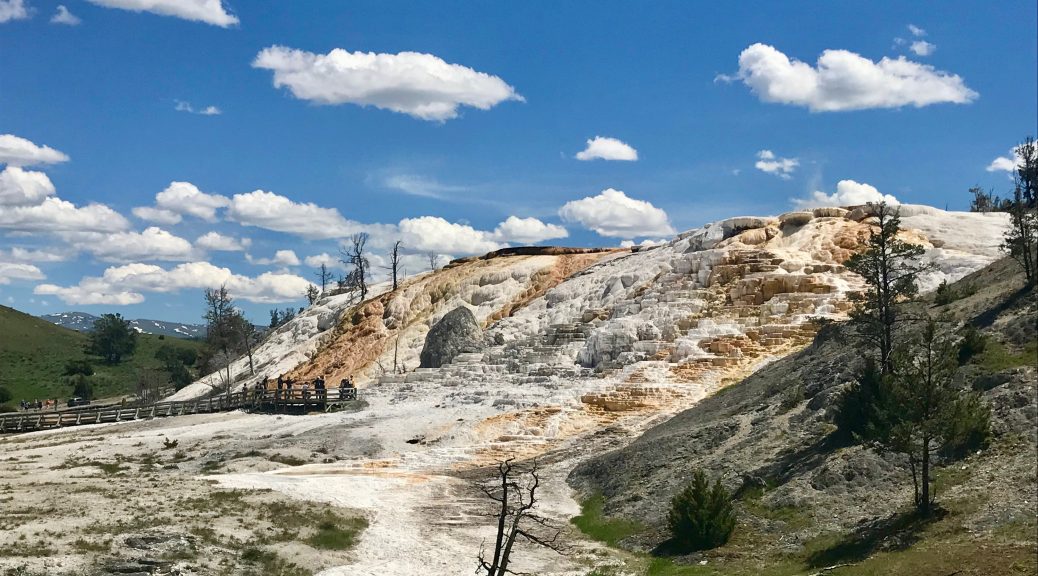On learning that this year’s conference on Open Repositories would be held in Bozeman, Montana, I was initially perplexed. What an odd, out-of-the-way corner of the world in which to hold an international conference on the work of institutional digital repositories. After touching down in Montana, however, it quickly became apparent how appropriate the setting would be to this year’s conference—a geographic metaphor for the conference theme of openness and sustainability. I grew up out west, but coastal California has nothing on the incomprehensibly vast and panoramic expanse of western Montana. I was fortunate enough to pass a few days driving around the state before the conference began, culminating in a long afternoon spent at Yellowstone National Park. As we wrapped up our hike that afternoon by navigating the crowds and the boardwalks hovering over the terraces of the Mammoth Hot Springs, I wondered about the toll our presence took on the park, what responsible consumption of the landscape looks like, and how we might best preserve the park’s beauty for the future.

Tuesday’s opening remarks from Kenning Arlitsch, conference host Montana State University’s Dean of Libraries, reflected these concerns, pivoting from a few words on what “open” means for library and information professionals to a lengthier consideration of the impact of “openness” on the uniqueness and precarity of the greater Yellowstone eco-system. Dr. Arlitsch noted that “[w]e can always create more digital space, but we cannot create more of these wild spaces.” While I agree unreservedly with the latter part of his statement, as the conference progressed, I found myself re-evaluating the whole of that assertion. Although it’s true that we may be able to create more digital space with some ease (particularly as the strict monetary cost of digital storage becomes more manageable), it’s what we do with this space that is meaningful for the future. One of my chief takeaways from my time in Montana was that responsibly stewarding our digital commons and sustaining open knowledge for the long term is hard, complicated work. As the volume of ever more complex digital assets accelerates, finding ways responsibly ensure access now and for the future is increasingly difficult.
“Research and Cultural Heritage communities have embraced the idea of Open; open communities, open source software, open data, scholarly communications, and open access publications and collections. These projects and communities require different modes of thinking and resourcing than purchasing vended products. While open may be the way forward, mitigating fatigue, finding sustainable funding, and building flexible digital repository platforms is something most of us are striving for.”
Many of the sessions I attended took the curation of research data in institutional repositories as their focus; in particular, a Monday workshop on “Engaging Liaison Librarians in the Data Deposit Workflow: Starting the Conversation” highlighted that research data curation is taking place through a wide array of variously resourced and staffed workflows across institutions. A good number of institutions do not have their own local repository for data, and even those larger organizations with broad data curation expertise and robust curatorial workflows (like Carnegie Mellon University, representatives from which led the workshop) may outsource their data publishing infrastructure to applications like Figshare, rather than build a local solution. Curatorial tasks tended to mean different things in different organizational contexts, and workflows varied according to staffing capacity. Our workshop breakout group spent some time debating the question of whether institutional repositories should even be in the business of research data curation, given the demanding nature of the work and the disparity in available resources among research organizations. It’s a tough question without any easy answers; while there are some good reasons for institutions to engage in this kind of work where they are able (maintaining local ownership of open data, institutional branding for researchers), it’s hard to escape the conclusion that many IRs are under-equipped from the standpoint of staff or infrastructure to sustainably process the on-coming wave of large-scale research data.

Elsewhere, from a technical perspective, presentations chiefly seemed to emphasize modularity, microservices, and avoiding reinventing the wheel. Going forward, it seems as though community development and shared solutions to problems held in common will be integral strategies to sustainably preserving our institutional research output and digital cultural heritage. The challenge resides in equitably distributing this work and in providing appropriate infrastructure to support maintenance and governance of the systems preserving and providing access to our data.


